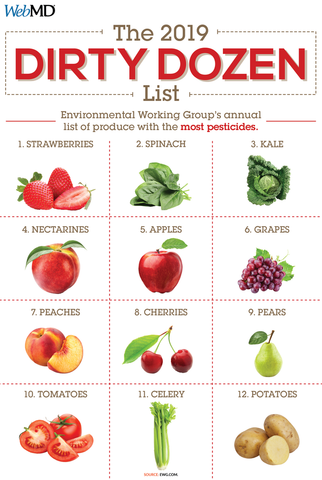How to Clean 2019’s Dirtiest Produce
Each year, the Environmental Working Group reviews more than 40,000 samples of nearly 50 different fruits and vegetables to learn which are the dirtiest - covered in the most pesticide residue - and which are the cleanest - you know, not so much pesticide residue. When you’re already trying to do as much good for your body as possible, and in light of 2018’s seemingly endless food recalls, it really can’t hurt to know more about your food.
The 2019 Dirty Dozen list, the 12 fruits and vegetables with the most pesticide residue, looked almost identical to the previous list. The exception? Sweet bell peppers fell off and kale joined the ranks.
- Strawberries
- Spinach
- Kale
- Nectarine
- Apple
- Grape
- Peach
- Cherry
- Pear
- Tomato
- Celery
- Potato

Yes, kale, that leafy super food that we couldn’t get enough of a few years ago, has at least 2 and as many as 18 different pesticides on it. They found 92% of all kale tested was contaminated, and 60% had dacthal (DCPA), a pesticide the EPA lists as a possible carcinogen. The average sample of all produce tested had 2 to 5 different residues.
That isn’t to scare, but inform and understand how to address it before you eat it. Some experts even caution there isn’t enough pesticide at play here to cause a concern. But, we’d rather err on the side of informed consumers, when you consider higher pesticide ingestion has been linked to fertility issues and higher organic ingestion linked to a lower risk of cancer.
Buying organic can make a big difference, as can properly washing produce before eating it. Not just a quick rinse under the sink, but truly cleaning...naturally!
“My favorite fruit and veggie wash is both simple and effective, and is made from ingredients you already have on hand,” shared Kait of ModernHippieHabits.com.
- Add one part apple cider vinegar, one part lemon, and two parts water to a clean spray bottle and shake to combine.
- Spray liberally on produce, rinse in cool water, and you are good to go!
- For larger batches or harder to clean produce like kale and broccoli, you can use the same recipe in a bowl and let produce soak.
“Being acidic, both lemon juice (citric acid) and ACV (acetic acid) have antibacterial and antimicrobial properties to help reduce bacteria and remove pesticide residue.”
The Clean 15 is the antithesis of the dirty list, where more than 70% of the fruits and vegetables tested had no residue at all. The list mirrored its predecessor, except mangoes fell off and mushrooms jumped on.
- Avocado
- Sweet Corn
- Frozen Peas
- Onion
- Papaya
- Eggplant
- Asparagus
- Kiwi
- Cabbage
- Cauliflower
- Cantaloupe
- Broccoli
- Mushroom
- Honeydew Melon
It’s better to eat as many fresh fruits and veggies as possible every day. If you can, and when available, choose organic, but don’t sacrifice your fill of plants because of cost or access. Just clean ‘em up and feel good about eating well.
You May Also Like:

